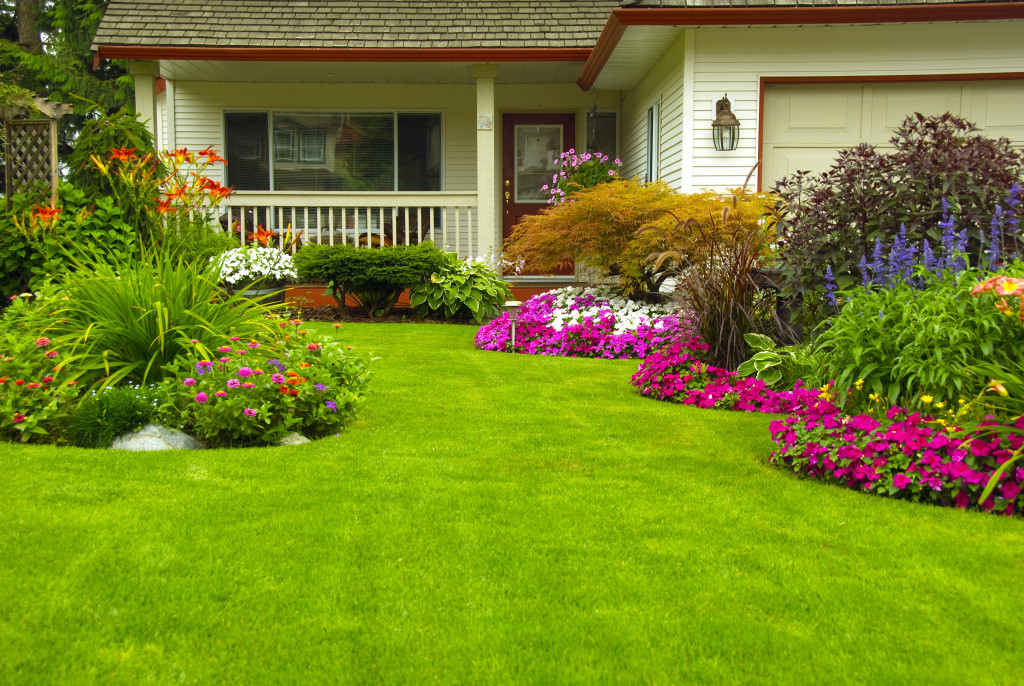- Select local plants for your landscape to ensure robust health and reduce the need for excessive care.
- Regularly prune and check trees for signs of disease or pest infestation to maintain health.
- Early detection and address of pests and diseases are crucial to prevent spread and damage.
- Consult professionals for advice on plant selection and care for a thriving, beautiful landscape.
Creating a beautiful landscape in your home may sound like a daunting task, but with the right strategies and techniques, it can be a fun and fulfilling experience. One of the key components of a thriving landscape is healthy plants. From choosing the right plants to regular maintenance, there are several essential tips for plant health that every homeowner should know. This article will discuss the best ways to keep your plants healthy and beautiful so that you can enjoy a flourishing landscape in your home.
Don’t Neglect Your Trees

Trees, often the most prominent features in people’s landscape, need special attention to stay healthy and vibrant. If you notice signs of disease or pest infestations, such as discolored leaves or stunted growth, don’t hesitate to consult professionals.
In severe cases, you might need to find a seasoned tree surgeon. They are experts in diagnosing and treating tree-related issues, and their intervention can save your trees and prevent further spread of diseases.
Furthermore, regular pruning is essential for maintaining the health and aesthetics of your trees. Pruning removes dead or damaged branches, promotes air circulation and sunlight exposure, and can also stimulate new growth.
Choose Plants That Thrive in Your Area
Selecting plants that are naturally adapted to your local climate and soil conditions is a fundamental way to ensure robust plant health. This strategy reduces the need for excessive care or artificial support, as local plants have evolved to thrive in your region’s specific conditions. Here are some things that you can do to know the plants that thrive in your area:
Research
Before heading to the nearest nursery or garden center, take some time to research the types of plants that thrive in your locale. You can do this by reading gardening books, browsing horticultural websites, or consulting local gardening clubs or extension services. Getting familiar with the regional flora not only helps you make informed decisions but also saves you time, money, and effort in the long run.
Observe
Observing the plants that grow well in your neighbors’ yards can provide valuable insights. Notice which plants are flourishing and which ones struggle. This method gives you a practical and reliable gauge of what works in your specific microclimate. Remember, what thrives in one garden might not do as well in another, even within the same town or city. Be sure to pay attention to the different conditions in your area, like sunlight exposure, soil type, and general climate.
Consult a Professional

Consulting a professional horticulturist or landscape designer can greatly aid your plant selection process. These experts have extensive knowledge and experience with various plant species and local conditions, making them an invaluable resource. They can provide tailored advice on choosing plants that not only thrive in your area but also suit your landscape design and personal preferences. Moreover, they can offer practical tips and techniques for plant care and maintenance.
Check for Pests and Diseases
Pests and diseases are common problems that can ruin your landscape if not caught early. Regularly check your plants for signs of pests or diseases and remove any affected areas immediately. Also, avoid overcrowding your plants, as this can make it easier for pests and diseases to spread. At the first sign of a problem, take immediate steps to address it to prevent it from becoming a bigger issue. Here are some immediate actions to take:
Remove Pests Manually
In some cases, a simple yet effective way to manage pest problems is by removing them manually. For small infestations, simply picking off the pests or using a water hose to dislodge them can be enough to protect your plants. It’s essential to wear gloves for this process to protect your hands and to dispose of the pests properly to prevent them from returning. Regularly inspect your plants for signs of pests, and stay vigilant, especially during the warmer months when pests tend to be more active.
Use Organic Pest Controls
Organic pest controls are an effective and eco-friendly way to manage pests in your garden. These methods rely on natural substances and processes to keep pest populations in check without causing harm to other beneficial organisms or the environment. Examples include the use of beneficial insects, botanical insecticides, or homemade sprays made from ingredients like garlic, pepper, or vinegar. It’s also important to remember that a well-balanced garden ecosystem with a variety of plants can naturally deter pests.
Address Diseases Promptly
If you notice any abnormal signs in your plants, such as discolored leaves, wilting, or spots, it’s likely that they’re suffering from a disease. Address these issues promptly to prevent them from spreading to other plants. Start by removing and disposing of the affected parts properly. Avoid composting diseased plant material, as this can spread the disease to other parts of your garden. For serious infections, using organic fungicides can be beneficial.
Maintaining a beautiful landscape in your home requires effort, but with these essential tips, you can set your plants up for success and enjoy a thriving landscape. By choosing the right plants, providing the right amount of water and nutrients, regularly pruning and trimming, checking for pests and diseases, and adapting care to the season, you can have a stunning and healthy landscape in your home. These steps may seem small, but they make a significant difference in promoting plant health and achieving a beautiful landscape that you can be proud of.
